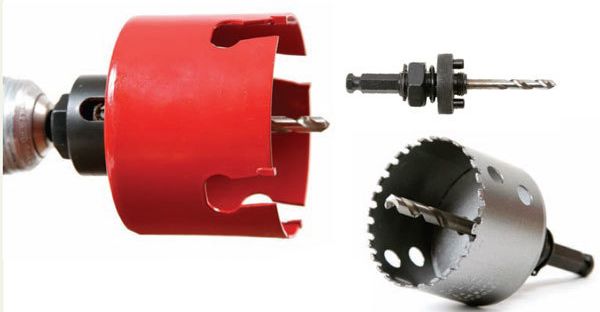Tool Review: Hole Saws for All Sorts of Materials
Bimetal saws are inexpensive and versatile, but don’t overlook the specialty tools designed to make clean cuts in less common materials.

Synopsis: Hole saws seem so straightforward that it can be tough to believe that they come in a such a huge variety of styles and materials. For this tool review, editorial adviser Mike Guertin narrowed his focus to examine the field of 2-1/8-in. bimetal hole saws. After testing saws from 14 manufacturers, Guertin found them all to be roughly equal in performance. This article includes information about other styles of hole saws, such as carbide-tipped, sheet metal, carbide grit, tungsten carbide, diamond grit, and a collection of specialty saws.
On the face of it, there’s nothing too complicated about hole saws: They chuck into handheld drills and drill presses to make 1⁄2-in.- to 6-in.- dia. holes. But after digging into the subject a little deeper for this story, I found that there is a dizzying array of boring tools designed to make holes in nearly all construction materials. So even though most bimetal, general-purpose hole saws work well for common tasks, don’t overlook the specialty tools that might perform better for specific tasks. Also, keep in mind that there are a few styles of mandrels that manufacturers use for their saws, and that there are pros and cons for each.
I recently examined the six categories of hole saws: bimetal, carbide-tipped, sheet metal, carbide grit, tungsten carbide, and diamond grit. Altogether, there are far too many to test, so I limited my trials to the bimetal saws from 14 different manufacturers. After all, bimetal hole saws are the most versatile and most common of the bunch. However, I’ve included a survey of the other five types to help you decide when a specialty saw might be a better alternative.
It’s a dead heat once you remove the saws’ labels
I tested 2 1⁄8-in.-dia. bimetal saws from 14 manufacturers to see if there were any appreciable differences that an average carpenter would notice. Cut speed and durability topped my list of criteria, so I set up a series of timed tests. I began by drilling five holes through 2x stock, then made a pass through 14-ga. sheet metal, followed by multiple durability cut tests through hardwood, drywall, and nail-embedded lumber.
Thirteen of the brands were virtually equal in performance; only the model from Ideal failed to cut through wood after cutting through sheet metal. Timed tests showed no significant difference in cut speed through any of the woods. Even after eight successive cuts through sheet metal and cuts through six 0.148-in.-dia. nails, most of the bimetal saws lost only a couple of seconds in a repeat of the timed wood-boring test. I noticed a slight dulling of the teeth after cuts through sheet metal, but it didn’t seem to affect cut speed on any of the saws.
One culprit affects speed of cut: the paint used to mark the saws. The heat of the cut seems to soften the paint, which then binds with sawdust and clings to the material being cut. Like barnacles on the bottom of a boat, the drag is evident. You have two options: Choose a hole saw with non gumming paint, or remove the paint. I ran all the hole saws through blocks of 2x stock 10 to 20 times, then scraped and sanded the gummy mess off the models that were impaired. Only the Bosch, the Vermont-American, the Craftsman, the Starrett, and the DeWalt remained gum-free and performed well on the cut-speed test without having their paint removed first.
For more photos and details, click the View PDF button below:
Fine Homebuilding Recommended Products
Fine Homebuilding receives a commission for items purchased through links on this site, including Amazon Associates and other affiliate advertising programs.

Handy Heat Gun

8067 All-Weather Flashing Tape

Affordable IR Camera






















